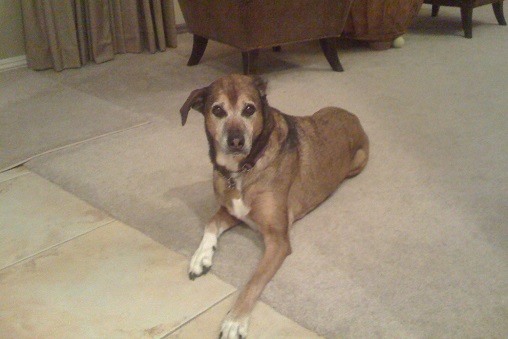
Table of Contents[Hide][Show]
It took a while to find our rhythm, but eventually Sophie and I worked out a daily schedule that met her needs. We found that taking care of a paralyzed dog requires a good routine and work ethic.
A solid routine makes life smooth on the good days and a strong work ethic will get you through the wild times when your schedule gets tossed out the window. The health of a disabled dog is unpredictable.
I guarantee that at least one time you’ll find yourself hosing your dog off in the shower at 2a.m. And there will be multiple days at your vet’s office because your pup has a urinary tract infection that wouldn’t go away.
Life with a paralyzed dog is more than putting your pet into a wheelchair. It’s complicated, messy, time-consuming and the most rewarding job I’ve ever had.

Ask & Discover
Get personalized content recommendations and answers drawn from our website. Simply type your question or topic of interest, and our AI assistant will help you find relevant articles, tips, and insights. You can also have a natural conversation to explore topics in more depth.
My experience
This set of lessons isn’t meant to stop you from caring for your dog. I just want to make you aware of what can happen by sharing my experience.
I’m confident you’ll be able to rise to the occasion. After all, you know your dog better than anyone.
And please keep in mind that every case of paralysis is unique. There are lots of conditions that cause a dog to lose the ability to walk and just because my dog had a certain experience, it doesn’t mean your fur kid will have the same.
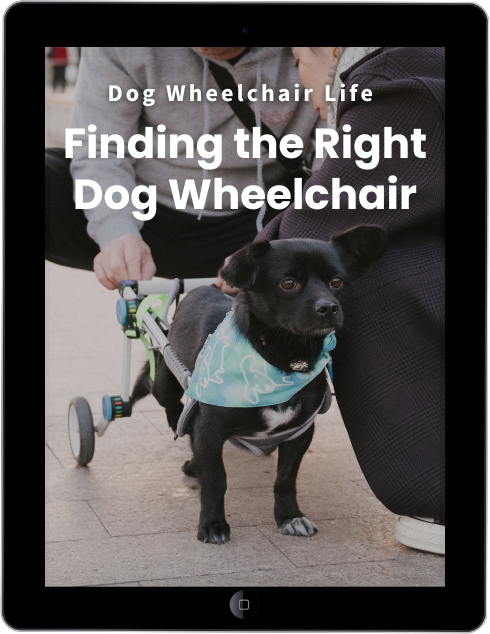
eBook
Find The Right Dog Wheelchair For Your Pet
Your dog has a mobility problem, and you want to buy a wheelchair. But do you know what kind of cart will work best for your dog’s individual needs? After a decade of teaching pet owners how to make the right choice, I put the information into an eBook!
Lesson Six – Taking care of a paralyzed dog daily routine
Here’s a quick glimpse into our daily schedule.
- 6:00am. – Wake up and slip Sophie into her Walkabout harness. Head directly to the backyard to manually express her bladder.
- 6:15a.m. – Head into the kitchen for the dogs’ breakfast.
- 8:30a.m. – Set Sophie in her bed by my desk for the morning while I worked.
- 12 noon – 1p.m. – Head to the lawn to manually express Sophie’s bladder.
- 1p.m. – Back to the desk to work with Sophie at my side.
- 3p.m. – Go for an afternoon walk with the dogs and family.
- 5:30p.m. – 6p.m. – Dinner for the dogs followed by expressing Sophie.
- 7p.m. – Games and playtime for all 3 dogs.
- 9:30 – 10p.m. – Manually express Sophie one more time before bed.
- 10:30p.m. – Bedtime.
Lesson Seven – There will be 2a.m. showers
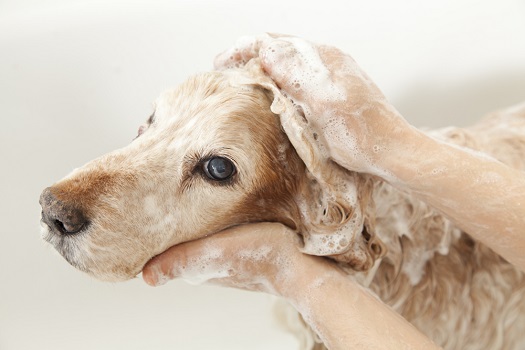
Beware, this lesson deals with doggie poop!
Like most paralyzed dogs, Sophie was both urinary and fecal incontinent. At first her bladder leaked and we used diapers at night. But as her condition progressed, she became less able to push out any urine. We compensated by learning to express her bladder.
That meant we stopped using diapers at night. Sophie wasn’t happy wearing one and for the most part, once we took her outside for her last bathroom break, she was good until the morning.
However, we never got the hang of timing her bowel movements. Generally, they were just little accidents that required us to “grab a bag and toss” the contents.
Every once in a while, there would be an accident in the middle of the night. It usually happened when Sophie was in a deep sleep, after a busy day.
And because she was in a deep sleep, poor Sophie would roll into the mess.
This usually happened around 2a.m. Ken or I would wake up to the nasty odor. One of us would creep out of bed to see if we could get away with a “grab and toss.”
On the nights where the mess was too much, one of us would take the stack of dog towels into the bathroom and get the shower ready. The other person took charge of putting Sophie’s bed into the washer and spraying air freshener throughout the room.
Even though Ken and I were dead tired, we knew the problem had to be cleaned immediately. Dogs who lie in their urine or fecal matter can develop rashes and urine scald on their skin from the ammonia.
We felt bad for Sophie. She was embarrassed by the accidents. Ken and I would soothe her and then go about the job of cleaning her and putting her back to bed. We always had a second dog bed ready for these emergencies.
Lesson Eight – Preventing urinary tract infections and pressure sores
Sophie was lucky in that she had only two major Urinary Tract Infections (UTI). Recurring UTIs is a common problem for incontinent pets. They’re painful and can be hard to treat.
UTIs are an infection that’s caused when bacteria grows in the bladder or urethra. Incontinent dogs are prone because their bodies can’t fully empty the urine.
I missed all of the warning signs when Sophie had her first infection. I didn’t notice the color of her urine had become darker and more concentrated. And I didn’t recognize the strong odor from her pee.
All I knew was her body seemed to be fighting me when I expressed her and that was probably due to pain.
I knew we had a big problem when a mixture of urine and blood poured from her body. Sophie had to go on some pretty potent antibiotics to clear up the infection.
After that I learned the signs of a UTI and ways to prevent it:
- Keep your dog on a strict bathroom schedule.
- Make sure your dog’s bladder is completely empty every time you express it.
- Watch for changes in the urine odor. A strong ammonia smell is bad news.
- Watch for changes in the urine color. Bright yellow urine points to dehydration while a dark color can indicate an infection or blood.
- Look for signs of discomfort in your dog.

Get the Essential Guide
The Essential Guide of Products for Handicapped Dogs e-book is a labor of love for me. I wrote it to answer your most pressing questions about where to find the best products for your wheelchair dog. You’ll find products you didn’t know existed and each will improve your dog’s quality of life. Print a copy and keep it by your side.
How to prevent pressure sores
A second complication paralyzed dogs can experience are pressure sores. Decubitus ulcers or pressure sores happen when the skin breaks down due to chronic injury. You see it when a disabled dog lies on a hard surface for an extended period of time.
Able-bodied dogs are able to change positions when they sense they’ve rested too long on one side. Paralyzed dogs who’ve lost sensations in their lower body and limbs have no way of knowing when this is happening.
They need your help to gently flip them into a new position on the opposite side of their body.
Paralyzed dogs are also susceptible to losing muscle mass around their weakened limbs. The bony areas in their hips and limbs are exposed to added pressure which in turn breaks down the skin and causes deep open wounds. These wounds are painful and hard to treat.
Here are ways to prevent them:
- Change your dog’s position every 2-3 hours.
- Invest in a quality orthopedic dog bed.
- Do range of motion physical therapy exercises to keep the joints and muscles flexible and strong.
- Learn massage therapy for the hips and limbs. It’s a good way to keep the blood flowing to these areas. (check with your vet before implementing any new exercise)
Lesson Nine – keep the water flowing
I live in the Las Vegas desert so I was already keenly aware of the importance of water for people and animals. But after Sophie’s paralysis I learned to keep the water flowing to prevent future UTIs.
Dogs who are well-hydrated are less likely to develop recurring urinary tract infections.
Doing this posed a problem I didn’t expect. Sophie wasn’t able to scoot around like most paraplegic pets.
That meant she couldn’t get to her water bowl on her own. She needed my help.
At first, I placed a bowl next to her inside the dog bed. She was able to wiggle across the bed and drink whenever she wanted. But later in her disease her body was less agile and she’d tip the bowl over.
It led to having a having water bowls in every room in the house. She learned to bark when she was thirsty and I would put the bowl in front of her.
This was just another example that a good routine and a strong work ethic are needed to be a good caretaker. Having a paralyzed dog is full of unexpected challenges and every changing needs.
One last chapter to read: The Importance of Good Communication

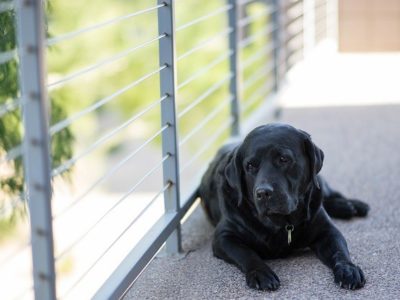
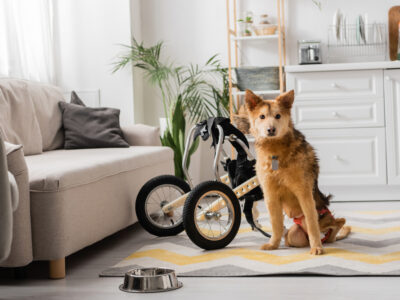
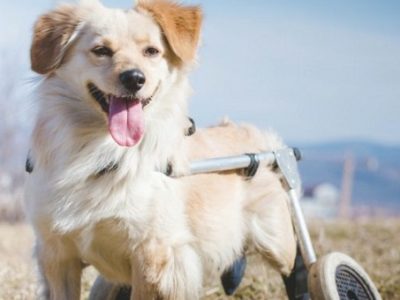

Thank you for this article – my dog has just started showing the early signs of degenerative myelopathy and I have been searching for this exact information to help prepare for the nitty gritty stuff! She can still get around fine right now but I want to be prepared for the road ahead and know what our daily routine will look like- thank you for posting!
Becca,
I’m happy the article was helpful.
Sharon,
Thank you SO MUCH for this article. My 10yo Shih Tzu, Starbuckii went down fast. On Monday, 28 March 2022, we had a regular morning. That afternoon, around 4pm, she couldn’t walk. After a few days in the hospital, being diagnosed with IVDD and now paralyzed from her mid-section down, I am an emotional wreck. I opt not to have surgery due to her doctor’s recommendation. I was taught how to express her bladder, what medicines to give, recommendations to get a sling and eventually a wheelchair. Today is the first day my sweetheart is home AND it’s hard. My mom is here to assist with Starbuckii, which makes it a lot less stressful for Starbuckii and myself. I am grateful for you and thank you for sharing your experiences.
Please keep sharing, recommending,advice.. I’m a total sponge right now.
Emma, I’m sorry to hear about your dog. You’ll be able to find lots of information about the daily care of your pup on the website. Please let me know if you have any questions.
-Sharon
Emma, I wanted to make sure you had a copy of this free E-book, Dogs With IVDD, Frequently Asked Questions For Pet Owners. Here’s the link: https://dogwheelchairlife.com/wp-content/uploads/2021/07/Booklet-2-IVDD-KeepDesktop.pdf It gives an overview of the disease and links to posts on my website to help in the daily care of your dog.
Thank you so much for this page. I don’t know how I got the email from you, but I am so grateful. My 8 year old, male, border collie, Bear, became paralyzed from the waist down 8 months ago. The vet said he blew 2 discs on his spine, &, that while he could have surgery (to the tune of 8-10 thousand dollars) there would be no guarantee it would help him walk again. They couldn’t even tell us how to express him. (Thank God for YouTube) The scheduling is so true. My husband & I both work full time. Thankfully, my work has been understanding about when my lunch has to be so I can take care of Bears expression.
So appreciative of this page right now.
Hi Teresa,
I’m sorry to hear about your dog, but I’m glad my advice was helpful. I don’t know how your email landed in my Inbox, but to bring you up to speed, dogwheelchairlife.com is a website that teaches pet parents how to take care of a paralyzed dog. You’ll find lots of articles and videos to help. Because your veterinarian recommended a conservative approach to heal Bear, I want to recommend two articles on my site: Crate Rest https://dogwheelchairlife.com/when-crate-rest-is-prescribed-for-your-ivdd-dog/
and The Cambridge IVDD Study https://dogwheelchairlife.com/cambridge-ivdd-study-how-conservative-care-heals-dogs/ Best wishes, Sharon